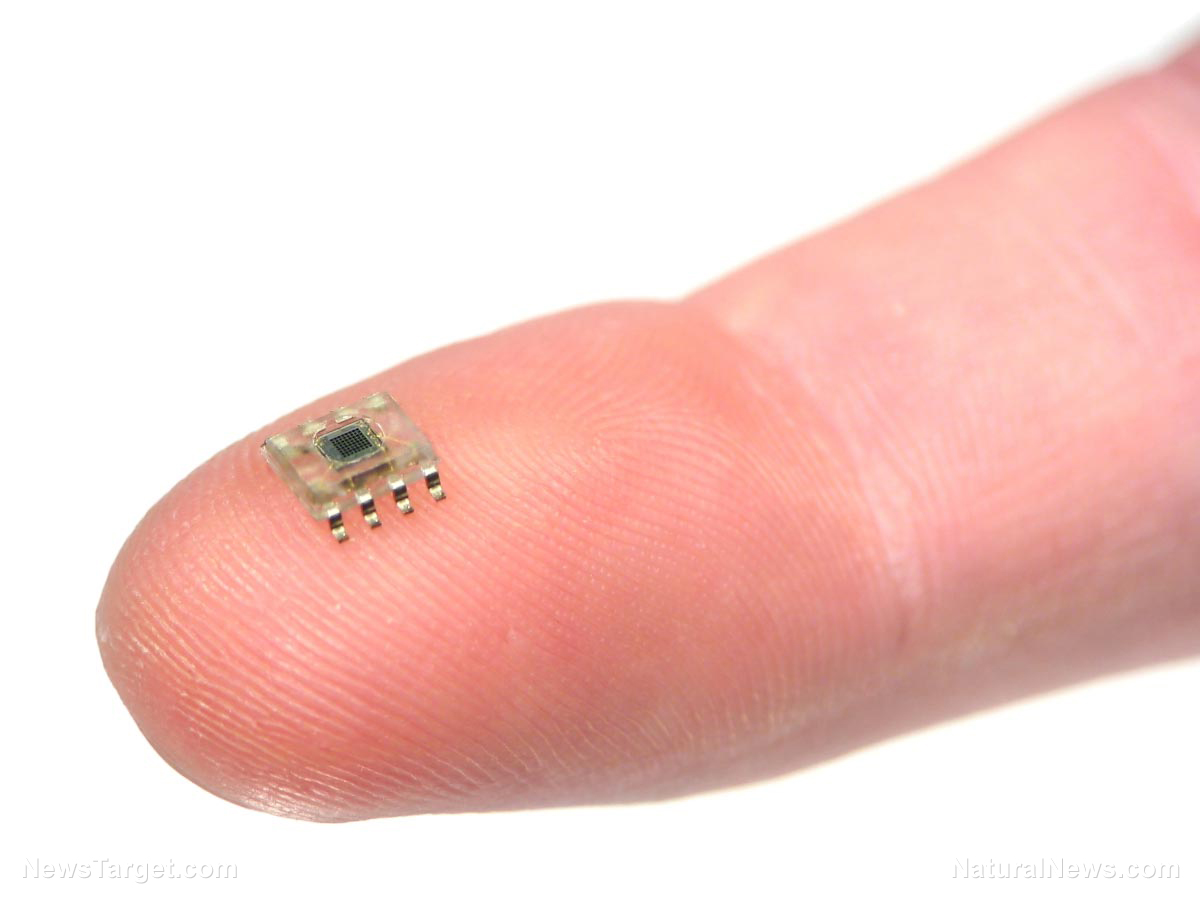DARPA uses mainstream media to flaunt implantable microchip “to stop coronavirus in its tracks”
12/13/2021 / By Nolan Barton

Dr. Matt Hepburn of the Defense Advanced Research Projects Agency (DARPA) flaunted on national television an implantable microchip, which he claimed is designed to stop coronavirus (COVID-19) infection in its track.
“That tiny green thing in there, you put it underneath your skin and what that tells you is that there are chemical reactions going on inside the body and that signal means you are going to have symptoms tomorrow,” Hepburn told Bill Whitaker of CBS news program “60 Minutes.”
“It’s like a ‘check engine’ light.”
Microchip is now in late-stage testing
Hepburn, recruited by DARPA eight years ago, said the microchip is now in late-stage testing. (Related: DARPA awards $40 million for research into memory-controlling implants.)
“It’s not some dreaded government microchip to track your every move, but a tissue-like gel engineered to continuously test your blood,” said Hepburn, an infectious disease physician and retired army colonel.
Hepburn related that the aircraft carrier USS Theodore Roosevelt had been hobbled last year when 1,271 crew members tested positive for COVID-19. He hinted that the spread of the virus would have been prevented if everyone on board had their health monitored with the subdermal implant.
“Sailors would get the signal, then self-administer a blood draw and test themselves on site. We can have that information in three to five minutes,” he said. As you truncate that time, as you diagnose and treat, what you do is you stop the infection in its tracks.
DARPA is a research and development agency of the Department of Defense responsible for the development of emerging technologies for use by the military. Thus, its technologies are mostly for military purposes. But with the mainstream media touting the implantable microchip as a way to finally end the pandemic, using it in civilians is very much a possibility.
There lies the problem. DARPA is not exactly a trusted agency.
In 2016, MailOnline reported that DARPA “is already working on microchips that can be implanted into soldiers’ brains to make them more resilient to warfare.” (Related: DARPA rumored to be genetically modifying humans to create zombie super soldiers.)
The agency’s reputation was further damaged the following year when it was found investing $100 million into “gene drive” research in an effort to procure genetic extinction technologies. Andrea Crisanti, an Imperial College London professor who pioneered the gene drive research, admitted that he has been hired by DARPA on a $2.5 million contract.
“Many countries [will] have concerns when this technology comes from DARPA, a US military science agency,” an unnamed United Nations diplomat told the Guardian at the time.
DARPA’s collection of weird and controversial projects over the years
DARPA was created on February 7, 1958, by then-President Dwight Eisenhower in response to the Soviet launching of Sputnik 1 in 1957. The agency collaborates with academia, industry and government partners to formulate and execute research and development projects and expand the frontiers of technology and science.
While the agency is credited with the advent of internet and global positioning system (GPS), it has also been involved in some weird and controversial projects.
DARPA’s Engineering Living Materials program sought to create building materials that can be grown where needed and have the ability to repair themselves when damaged. As researchers make progress with 3D-printed organs and tissues, DARPA hopes to use similar technologies to create hybrid materials that can shape and support the growth of engineered cells.
The agency’s Blood Pharming program was projected to increase the efficiency of production and lower the high costs associated with growing red blood cells. Blood pharming is the process of creating red blood cells from cell sources in a lab rather than inside a human body. The program would have greatly increased access to transfusable blood for soldiers and hospitals around the world and reduced the risk of disease transmission during a transfusion. The program was no longer listed in recent budget documents.
In 2006 DARPA wanted to implant transmitters in insects to use them for surveillance. The Hybrid Insect Micro-Electro-Mechanical Systems program was run by teams from the University of Michigan and Cornell University. In 2009, Cornell engineers revealed a prototype of a radioactively-powered transmitter for cyborg insects.
The agency also funded research on solutions for the negative effects war can have on soldiers. The Systems-Based Neurotechnology for Emerging Therapies program is tasked with creating “an implanted, closed-loop diagnostic and therapeutic system for treating, and possibly even curing, neuropsychiatric illness,” according to a DARPA press release. The program wants to make a brain implant that will help soldiers struggling with post-traumatic stress disorder (PTSD), traumatic brain injuries, anxiety, substance abuse and more.
Recognizing the effect the weight of soldiers’ loads can have on them, DARPA began working with robotics company Boston Dynamics to create the Legged Squad Support System (LS3). DARPA’s website states that the program’s goal is “to develop a robot that will go through the same terrain the squad goes through without hindering the squad’s mission.”
DARPA also invested in researching space travel. Project Orion is a program from 1958 intended to research a new means of spaceship propulsion. This hypothetical model of propulsion relied on nuclear bomb detonations to power a craft forward and was supposedly capable of hitting astonishing speeds. However, DARPA officials were worried about nuclear fallout. The project was dropped when the Partial Test Ban Treaty of 1963 outlawed detonations of nuclear weapons in outer space.
Follow MilitaryTechnology.news for more news and information related to technologies developed by DARPA.
Sources include:
Tagged Under: anxiety, blood pharming, brain injuries, coronavirus, covid-19, cyborg insect, DARPA, Global Positioning System, health freedom, Liberty, Medical Tyranny, microchip, nuclear bomb, obey, Orwellian, pandemic, privacy, Project Orion, PTSD, sheeple, Sputnik 1, substance abuse, surveillance, tracking, Tyranny
RECENT NEWS & ARTICLES
COPYRIGHT © 2017 FUTURETECH.NEWS
All content posted on this site is protected under Free Speech. FutureTech.news is not responsible for content written by contributing authors. The information on this site is provided for educational and entertainment purposes only. It is not intended as a substitute for professional advice of any kind. FutureTech.news assumes no responsibility for the use or misuse of this material. All trademarks, registered trademarks and service marks mentioned on this site are the property of their respective owners.




















